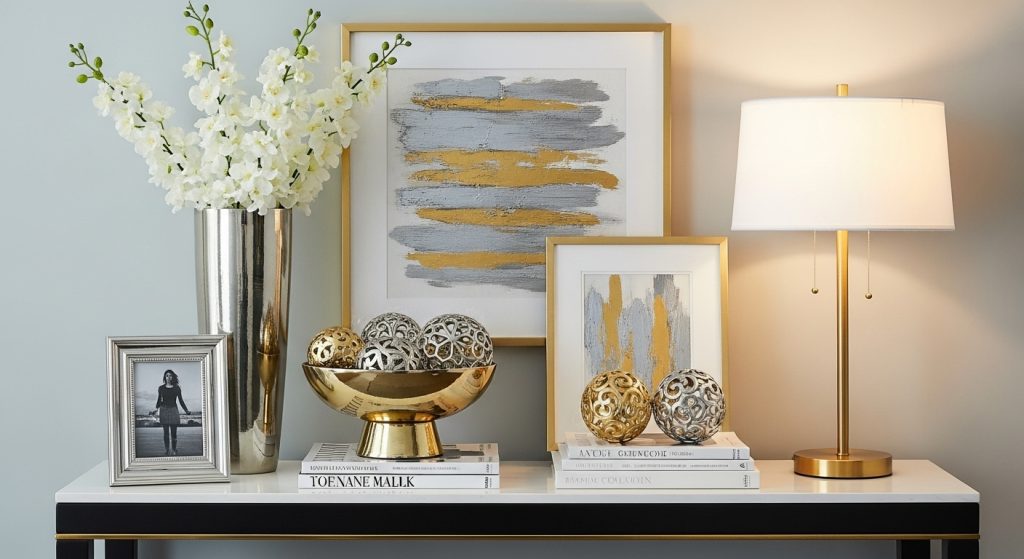Mastering the art of mixing metallic tones: silver and gold console decor is a sophisticated design technique that can elevate your entryway or living space from ordinary to extraordinary. Gone are the days of rigid rules dictating that you must choose one metal finish and stick to it. Today’s high-end interiors confidently blend the warmth of gold with the coolness of silver, creating a look that is rich, layered, and undeniably chic. However, achieving this effortless blend requires a thoughtful approach.

This definitive guide provides an expert framework, revealing the professional secrets to combining these precious tones harmoniously on your Console table for a stunning, curated, and balanced result.
What is the Core Principle of Mixing Silver and Gold Successfully?
The core principle of mixing silver and gold successfully is intentional balance through dominance and repetition. Instead of a random scattering of different metals, the key is to choose one metal as the dominant finish and use the other as a deliberate accent. This creates a cohesive foundation, while repeating each finish in varying textures and forms makes the mix feel curated and sophisticated, not chaotic.
This approach moves beyond outdated design “rules” and embraces a more modern, collected aesthetic. It acknowledges that a thoughtfully blended palette of metals adds depth and visual interest. By establishing a clear hierarchy—one star and one supporting actor—you prevent the different finishes from competing. You create a harmonious dialogue between the warm and cool tones. This curated approach is essential for achieving the high-end look seen in luxury console table ideas for elegant entryways. The trend towards mixed metals in interior design reflects a broader shift towards more personalized and layered spaces.
Why Do Undertones Matter When Mixing Metals?
Understanding undertones is a professional secret to harmonious metal mixing. Not all golds and silvers are created equal. Some lean warm, while others lean cool. Pairing metals with similar undertones creates a more cohesive and less jarring blend. Generally, warmer golds (like traditional yellow gold or brass) pair best with warmer silvers (like polished nickel or champagne silver). Cooler golds (like pale champagne gold) pair better with cooler silvers (like chrome or bright silver).
While high-contrast pairings can work, matching undertones provides a safer and often more sophisticated starting point. Think about the overall temperature of your room. Does your paint color lean warm or cool? Does your flooring have warm or cool tones? Choosing metals whose undertones align with your room’s existing palette will create a more integrated and seamless look. This attention to detail is a hallmark of professional styling.
How Does Texture Play a Crucial Role?
Texture plays a crucial role by adding depth and preventing the metallic finishes from looking flat or overly uniform. Mixing different textures within the same metal family (e.g., polished gold and brushed gold) and across different metals (e.g., hammered silver and smooth brass) creates a richer, more dynamic, and visually interesting composition.
Texture helps the different metals coexist more gracefully. A highly polished chrome lamp might feel too stark next to a matte brass console. But pairing a brushed brass console with hammered nickel accessories creates a softer, more nuanced contrast. Consider incorporating these varied finishes:
- Polished: High shine, very reflective.
- Brushed/Satin: Softer, linear texture, less reflective.
- Hammered: Dimpled texture, catches light in interesting ways.
- Antiqued/Aged: Darker patina, feels vintage and less shiny.
- Matte: Non-reflective, very modern. A thoughtful mix of these textures adds a layer of sophistication that elevates the entire vignette.
How Do You Establish a Dominant Metal?
Establishing a dominant metal is the foundational step in creating a cohesive mixed-metal scheme. This means choosing one metal finish – either gold or silver – that will be the most prominent in your console table display. This dominant metal will typically be featured on the largest pieces, such as the console table frame itself or the anchor mirror above it.
This hierarchy prevents the visual confusion that can arise from an equal, fifty-fifty split between competing finishes. The dominant metal sets the primary tone (warm or cool) for the vignette. The secondary metal then acts as a highlight or accent, adding contrast and visual interest without overwhelming the overall composition. A common guideline in design is the 60/30/10 rule; adapted for two metals, aim for roughly a 70/30 split between your dominant and accent metal.
How to Use Gold as the Dominant Metal?
To use gold as the dominant metal, make it the star of the show. This is often achieved by choosing a console table with a prominent gold or brass frame. Alternatively, a large, statement mirror with a substantial gold frame can serve as the dominant element. Once this foundation is set, silver or nickel can be introduced in smaller doses through accessories like lamp bases, picture frames, or decorative trays. This approach creates a warm, glamorous, and inviting look. For specific strategies, explore our detailed guide on how to style a gold console table like a designer.
How to Use Silver as the Dominant Metal?
To use silver (including chrome or polished nickel) as the dominant metal, select a console table with a sleek silver frame or top it with a large, impactful silver-framed mirror. Silver dominance creates a cooler, more modern, and often more serene aesthetic compared to gold. Gold or brass can then be introduced as warmer accent pieces. This could be through a lamp with a brass base, gold-toned picture frames, or a small brass decorative object. This contrast between the cool silver foundation and the warm gold accents creates a sophisticated and dynamic balance.
What Are the Secrets to Strategic Placement and Layering?
Strategic placement and layering are the techniques that make the mix of metals feel intentional and curated. It is not enough to simply have both gold and silver items; they must be arranged thoughtfully to create a harmonious composition. This involves considering proximity, repetition, and the interplay with non-metallic elements.
How Do You Layer Metals Effectively on the Tabletop?
Layering metals effectively involves creating visual “breathing room” between different metallic finishes. Avoid placing a shiny gold object directly next to a shiny silver object, as they can visually clash. Instead, use non-metallic items to create a buffer or transition.
- Use Trays: Place metallic accessories on a tray made of a contrasting material like marble, wood, or lacquer.
- Use Books: Elevate a metallic object by placing it on a stack of books. This separates it from the console’s surface and other nearby items.
- Mix with Ceramics/Stone: Group a metallic candlestick with a ceramic vase or a stone sculpture. The matte texture provides a grounding contrast to the shine.
How Does Lighting Enhance Mixed Metallics?
Lighting plays a crucial role in enhancing the beauty of mixed metals. Position table lamps so their light reflects off the metallic surfaces. This highlights their different finishes and creates a warm, inviting glow. Consider the material of the lamp base itself – a crystal lamp can add sparkle without introducing another metal, while a lamp with a base that combines both gold and silver elements can serve as a unifying piece. The interaction of light and reflective surfaces is a key component detailed in our guide to high-end hallway styling tips using mirrors and lighting.
Why is Repetition the Key to Intentional Mixing?
Repetition is the key to making your mix of metals feel deliberate and cohesive, rather than random or accidental. Each metallic finish you introduce should appear at least twice, and ideally three times, within the vignette. For example, if your dominant console is gold and you introduce a silver lamp, you should repeat the silver finish somewhere else – perhaps in a picture frame or a small decorative box. This repetition creates a visual rhythm. It assures the eye that the mix is intentional and part of a planned design scheme.
How Do You Incorporate Non-Metallic Materials for Balance?
Incorporating non-metallic materials is absolutely essential for balancing the shine and preventing metallic overload. These materials provide a grounding contrast, add warmth and texture, and help to integrate the console vignette with the rest of the room’s decor. A successful mixed-metal scheme relies heavily on these supporting players.
What is the Role of Natural Materials Like Wood and Stone?
Natural materials like wood and stone provide a crucial grounding element. The warmth and organic texture of wood (in a tray, box, or picture frame) offer a beautiful contrast to the coolness and shine of metals. The cool, smooth surface of marble or travertine (in a tabletop, lamp base, or decorative object) adds a layer of natural elegance. These materials prevent the display from feeling too artificial or overly glamorous. The use of natural materials in conjunction with metals is a hallmark of sophisticated design.
How Do Glass and Crystal Add Sparkle Without Competing?
Clear glass and crystal are excellent companions for mixed metals. They add sparkle, reflection, and a sense of lightness without introducing another competing color or finish. A crystal lamp base, a set of glass candlesticks, or a simple glass vase allow the beauty of the metallic console and accessories to shine through. Mirrored surfaces, such as a mirrored box or tray, can also be used effectively to amplify the light and reflections.
What is the Importance of Greenery and Florals?
Adding a touch of greenery or a simple floral arrangement is vital for softening the look and adding an organic element. A few stems of eucalyptus in a metallic vase, a small potted orchid, or even a high-quality faux plant can provide a necessary touch of life. The soft, natural forms of plants provide a beautiful counterpoint to the hard, geometric lines of the console and many metallic accessories. The biophilic design trend highlights the positive impact of incorporating natural elements indoors.
How Do You Troubleshoot Common Mixed-Metal Styling Issues?
Even with careful planning, sometimes a mixed-metal arrangement doesn’t feel quite right. Troubleshooting involves stepping back, analyzing the composition, and making small adjustments based on the core principles of balance, dominance, and repetition.
What if the Arrangement Looks Too Busy or Cluttered?
If the arrangement looks too busy, the solution is almost always editing. Remove one or two of the metallic accessories, especially the smaller ones. Increase the amount of negative space on the tabletop. Ensure that your dominant metal is clearly established and isn’t being overpowered by too many competing accent pieces. Sometimes, simply swapping out a shiny object for one with a matte finish can calm the composition.
What if the Mix Feels Too Cold or Too Warm?
If the mix feels unbalanced in temperature, adjust the ratio of warm golds to cool silvers. If the look is too cold (often the case with dominant chrome or silver), introduce more warm accents like brass candlesticks or a gold-toned object. Conversely, if a dominant gold console feels too overwhelmingly warm, introduce cooler silver elements in a lamp base or picture frames. You can also use non-metallic elements like a cool gray marble tray or artwork with blue tones to balance the warmth.
How to Ensure the Mix Looks Intentional, Not Accidental?
To ensure the mix looks intentional, rely heavily on the principles of dominance and repetition. Is one metal clearly the star? Does the accent metal appear at least twice? Are the metallic items thoughtfully grouped or layered with non-metallic buffers? Answering these questions can help diagnose why a mix might feel random. Often, simply adding one more small item in the accent metal’s finish is enough to create the necessary repetition and make the scheme feel complete.
Conclusion
Mastering the art of mixing metallic tones: silver and gold console decor is a hallmark of sophisticated, modern design. It is a confident move away from rigid rules towards a more curated and personal aesthetic. By establishing a dominant metal, thoughtfully layering in accents with varied textures, repeating finishes for cohesion, and balancing the shine with natural materials, you can create a stunning and harmonious vignette. The result is a luxury console table display that feels rich, dynamic, and effortlessly elegant—a perfect blend of warmth and coolness that makes a lasting impression.











